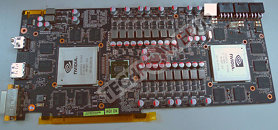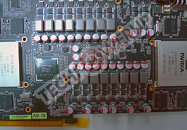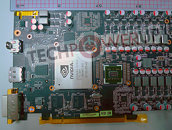- Joined
- Oct 9, 2007
- Messages
- 47,639 (7.44/day)
- Location
- Dublin, Ireland
| System Name | RBMK-1000 |
|---|---|
| Processor | AMD Ryzen 7 5700G |
| Motherboard | Gigabyte B550 AORUS Elite V2 |
| Cooling | DeepCool Gammax L240 V2 |
| Memory | 2x 16GB DDR4-3200 |
| Video Card(s) | Galax RTX 4070 Ti EX |
| Storage | Samsung 990 1TB |
| Display(s) | BenQ 1440p 60 Hz 27-inch |
| Case | Corsair Carbide 100R |
| Audio Device(s) | ASUS SupremeFX S1220A |
| Power Supply | Cooler Master MWE Gold 650W |
| Mouse | ASUS ROG Strix Impact |
| Keyboard | Gamdias Hermes E2 |
| Software | Windows 11 Pro |
After treating the enthusiast community to the Republic of Gamers (ROG) ARES Dual HD 5870 graphics accelerator, ASUS isn't wasting any time is designing its successor, referred to (for now) as "MARS II". This graphics accelerator uses two NVIDIA GeForce GTX 480 (GF100) GPUs on one board, that's right, the first dual-GPU accelerator based on GF100, which is dreaded for its thermal and electrical characteristics so much, that NVIDIA is content with having the second-fastest graphics card in the market (GTX 480), with no immediate plans of working on a dual-GPU accelerator.
ASUS' ambitious attempt is in the design stage deep inside its R&D, where the design is in an evaluation state. The R&D gave us some exclusive pictures of the MARS II PCB to treat you with. To begin with, the card's basic design is consistent with almost every other dual-GPU NVIDIA card in recent past. There are two independent GPU systems, each with its own VRM and memory, which are interconnected by an internal SLI, and connected to the system bus by an nForce 200 bridge chip. On this card, two GF100 GPUs with the same configuration as GeForce GTX 480 (GF100-375-A3) are used, each having 480 CUDA cores, and connecting to 1536 MB of GDDR5 memory across a 384-bit wide memory interface.

ASUS' innovations kick in right from the PCB, since it takes a lot of effort to keep such a design electrically stable, as well form an overclockers' product. MARS II uses a PCB with 3 oz copper layers to increase electrical stability, and used a strong VRM. Each GPU system is fed by an 8+2 phase VRM of its own, which use a new Super Alloy choke that reduces core energy loss. The card takes its power input from three 8-pin power inputs, which are fused.


The card is quad SLI capable, and can pair with another of its kind (and probably single GTX 480s). To cool this monstrosity, ASUS is coming up with a beefier than ever cooling solution. With the product being still at an evaluation stage, how long it will take to reach production, or whether it will in the first place, remains to be seen.
View at TechPowerUp Main Site
ASUS' ambitious attempt is in the design stage deep inside its R&D, where the design is in an evaluation state. The R&D gave us some exclusive pictures of the MARS II PCB to treat you with. To begin with, the card's basic design is consistent with almost every other dual-GPU NVIDIA card in recent past. There are two independent GPU systems, each with its own VRM and memory, which are interconnected by an internal SLI, and connected to the system bus by an nForce 200 bridge chip. On this card, two GF100 GPUs with the same configuration as GeForce GTX 480 (GF100-375-A3) are used, each having 480 CUDA cores, and connecting to 1536 MB of GDDR5 memory across a 384-bit wide memory interface.

ASUS' innovations kick in right from the PCB, since it takes a lot of effort to keep such a design electrically stable, as well form an overclockers' product. MARS II uses a PCB with 3 oz copper layers to increase electrical stability, and used a strong VRM. Each GPU system is fed by an 8+2 phase VRM of its own, which use a new Super Alloy choke that reduces core energy loss. The card takes its power input from three 8-pin power inputs, which are fused.


The card is quad SLI capable, and can pair with another of its kind (and probably single GTX 480s). To cool this monstrosity, ASUS is coming up with a beefier than ever cooling solution. With the product being still at an evaluation stage, how long it will take to reach production, or whether it will in the first place, remains to be seen.
View at TechPowerUp Main Site
Last edited:













